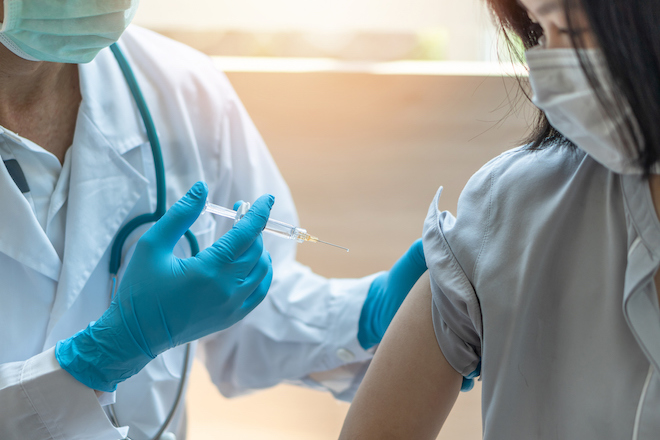
This article is published in collaboration with the International Vaccine Institute.
Collective action is needed more than ever and we want to thank the Asian Development Bank and the Southeast Asia Development Solutions (SEADS) for giving us this opportunity to discuss antimicrobial resistance through this op-ed and an upcoming webinar on 7 December.
While the world is still battling with the coronavirus disease (COVID-19) crisis, another pandemic has been steadily growing in the background. Antimicrobial resistance (AMR), often described as the “slow” or “unseen” pandemic, is responsible for approximately 700,000 deaths every year and estimated to rise to 10 million yearly with an annual cost of $100 trillion by 2050 if no action is taken.1
AMR is the ability of a microorganism like bacteria, viruses, and some parasites to stop an antimicrobial drug from working against it. As a result, standard treatments become ineffective, infections persist, and may spread to others—hence, the invisible spread and pandemic potential of AMR. In recent years we have seen bacteria that have developed resistance against all forms of antibiotics, including the so-called "last resort drugs," effectively rendering common infections such as pneumonia untreatable.
These superbugs represent a global threat not just in spreading drug-resistant infections but also by compromising basic infection control for standard operations and cancer treatments. If nothing is done, we could soon find ourselves in a “post antibiotic era” where even routine medical procedures become high risk and simple infections once again kill millions of people every year.
Many of us have been prescribed a course of antibiotics for a lingering fever or for generally feeling unwell for an extended period of time. Antibiotics are convenient, relatively cheap, and a proven choice against common infections. While this practice, or, empirical treatment based on a medical practitioner’s judgement, sometimes helps clear up underlying infections, antibiotics are not always necessary—in the case of the flu or COVID-19, for instance, which are both caused by viral infections. A medical system that relies too heavily on empirical treatment coupled with patients who use antimicrobials inappropriately (e.g., over the counter antibiotic sales, incomplete courses of antibiotics, sharing prescriptions, etc.) is unsustainable and further fuels the development of resistance. This rising trend will have a devastating toll on human life and significantly cost the global economy.
Vaccines are critical to the prevention and control of infectious diseases and an important tool for global health security2. This has been clearly illustrated in the COVID-19 pandemic, where vaccines—combined with other preventive measures such as masks and distancing—have been central to pandemic control efforts and responsible for turning the deadly disease into a much more limited and manageable one. Vaccines similarly present an important and more sustainable solution against AMR.
Vaccines can either work directly by reducing infections with both sensitive and resistant pathogens or indirectly through an effect on indiscriminate antibiotic use. However, as a complex global health issue spanning dozens of pathogens and types of infections, stopping AMR requires strategic targets for vaccine development and deployment against priority pathogens.
Short term—Improving roll out of existing vaccines against AMR
In 2017, the World Health Organization published a list of “AMR priority bacterial pathogens” to guide research priorities in the development of new and effective drugs to combat AMR.3 Currently, there are only three licensed vaccines that target priority bacterial pathogens: the pneumococcal conjugate vaccine (PCV), the Haemophilus influenzae type b (Hib) vaccine, and the typhoid conjugate vaccine (TCV).4 PCV reduces infection by resistant Streptococcus bacteria5 and typhoid conjugate vaccine was a key component in defeating an epidemic of typhoid caused by extensively drug resistant Salmonella in South Asia.6
Improving the coverage of these existing vaccines is an essential immediate step/short-term intervention.7 Currently 50 countries worldwide and 40% of the world’s infants (55.0 million) are not sufficiently covered by PCV immunization programs.8 The Hib is already included in most National Immunization Programs (NIPs), accounting for 99% of countries, though with suboptimal vaccine uptake in pockets of the populations.
In addition to the disproportionate allocation of COVID-19 vaccines across countries, the pandemic has significantly challenged the delivery and coverage of routine immunizations.9 It is imperative that countries re-establish and further enhance their existing NIPs to ensure sufficient coverage and infection prevention.
The last resistance-prone pathogen for which a vaccine already exists is Salmonella typhi and while broader use of the TCV has the potential to reduce both resistance and inappropriate antimicrobial use,10 scaling up its introduction has been limited. Prioritizing TCV vaccinations in the areas where typhoid is still highly prevalent would not only protect populations against an endemic disease with resistant strains, but ease burdens on medical systems, contribute to a more resilient economy, and reduce a reliance on antibiotics.11
Viral vaccines are also an important target as they can reduce inappropriate antibiotic use and thereby indirectly reduce AMR. The influenza and rotavirus vaccines, which protect against the flu and diarrheal infections, respectively, are two examples of existing viral vaccines that have shown to significantly reduce antibiotic mis- and over-use.12 13
Even though the World Health Organization (WHO) recommends inclusion of rotavirus vaccines in all NIPs, 97 countries (equivalent to 71.3 million infants) have yet to introduce the vaccine nationwide.8 Notably, this applies to high-income countries as well.14
We have also seen substantial antibiotic misuse among COVID-19 patients with up to 80% of patients receiving antibiotics although the actual prevalence of bacterial co-infections among COVID-19 patients is only around 8%.15 Hopefully, widespread COVID-19 vaccination can also help curb this inappropriate practice.

Long term—developing new vaccines against critical pathogens
For the remaining WHO priority pathogens, vaccines are not currently available but several are in development.16 Proof-of-concept evidence suggests that vaccine development is feasible for tuberculosis (TB), gonococcal disease, as well as enteric infections caused by Shigella, E. coli and non-typhoidal Salmonella.4 Two other pathogens listed by the US Center for Disease Control (CDC, but not WHO) as worrisome for AMR are streptococci—Group A streptococci cause "strep throat" while the Group B streptococcus causes infections around the time of pregnancy and delivery, in both mothers and newborns.17
Other very crucial and resistance-prone pathogens are those often responsible for hospital-acquired infections, which carry considerable treatment challenges, hospitalization cost and high fatality.18 Unfortunately, despite several vaccine candidates in the pipeline, whether they are technically feasible remains to be established for these pathogens (Campylobacter, Helicobacter, enterococci, Acinetobacter, Enterobacter, Staphylococcus, Pseudomonas, Clostridium difficile). Nevertheless, considering how vaccines are potentially both the first line of defense and final option against pathogens that have already acquired complete resistance,19 vaccine development is truly an urgent research need.20
The role of vaccine organizations in the fight against AMR
The International Vaccine Institute (IVI) is a non-profit international organization with a mission to discover, develop, and deliver safe, effective and affordable vaccines for global public health. With a particular focus on preventing and controlling diseases that disproportionally affect low- and middle-income countries, AMR has become a priority research area for IVI. Our work spans both the short-term goals of supporting vaccine introduction in disease endemic countries as well as the longer-term goals of discovering and developing novel vaccines for priority pathogens. IVI is currently working on developing vaccines for TB, typhoid, non-typhoidal Salmonella, Shigella, and group A streptococci. One example, among our multiple efforts to support TCV introduction across both Asia and the African continent, is a comprehensive vaccination campaign in Fiji aiming at eliminating typhoid and reducing AMR in both the population and the environment.
COVID-19 has demonstrated the destructive potential of a pandemic in our modern, connected world as well as the necessity for an accelerated pathway to new, safe, and effective vaccines and their broad use across every country in the world. The investment of resources, decisive political will, international solidarity, public health communication and intervention tactics, and scientific innovation inspired by COVID-19 is of the kind required to stop the AMR pandemic in its tracks. As a global health threat that affects everyone, everywhere, with serious ramifications to human and animal health, our food system, economy, and environment, it is critical that we take a One Health approach to apply short-term solutions to ease the burdens of AMR and invest in longer-term, sustainable solutions to build a safer future for all.
References
1. O'Neill J. The Review on Antimicrobial Resistance. Tackling Drug-Resistant Infections Globally: Final Report and Recommendations. 2016.
2. World Health Organization. Immunization Agenda 2030: A Global Strategy To Leave No One Behind. 2020
3. World Health Organization. Prioritization of Pathogens to Guide Discovery, Research and Development of New Antibiotics for Drug-Resistant Bacterial Infections, Including Tuberculosis. Geneva: World Health Organization; 2017(WHO/EMP/IAU/2017.12). ( Licence: CC BY-NC-SA 3.0 IGO. Geneva: World Health Organization, 2017.
4. Vekemans J, Hasso-Agopsowicz M, Kang G, et al. Leveraging Vaccines to Reduce Antibiotic Use and Prevent Antimicrobial Resistance: a WHO Action Framework. Clin Infect Dis 2021 doi: 10.1093/cid/ciab062 [published Online First: 2021/01/26]
5. Tomczyk S, Lynfield R, Schaffner W, et al. Prevention of Antibiotic-Nonsusceptible Invasive Pneumococcal Disease With the 13-Valent Pneumococcal Conjugate Vaccine. Clin Infect Dis 2016;62(9):1119-25. doi: 10.1093/cid/ciw067 [published Online First: 2016/02/26]
6. Yousafzai MT, Karim S, Qureshi S, et al. Effectiveness of Typhoid Conjugate Vaccine against Culture-Confirmed Salmonella Enterica Serotype Typhi in an Extensively Drug-Resistant Outbreak Setting of Hyderabad, Pakistan: a Cohort Study. The Lancet Global Health 2021;9(8):e1154-e62. doi: 10.1016/s2214-109x(21)00255-2
7. World Health Organization (WHO). Leveraging Vaccines to Reduce Antibiotic Use and Prevent Antimicrobial Resistance: An Action Framework. World Health; 2020. Licence: CC BY-NC-SA 3.0 IGO., 2020.
8. International Vaccine Access Center (IVAC). VIEW-hub Report: Global Vaccine Introduction and Implementation. Johns Hopkins Bloomberg School of Public Health, 2019.
9. Causey K, Fullman N, Sorensen RJD, et al. Estimating Global and Regional Disruptions to Routine Childhood Vaccine Coverage during the COVID-19 Pandemic in 2020: a Modelling Study. The Lancet 2021;398(10299):522-34. doi: 10.1016/s0140-6736(21)01337-4
10. Andrews JR, Baker S, Marks F, et al. Typhoid Conjugate Vaccines: A New Tool in the Fight against Antimicrobial Resistance. The Lancet Infectious Diseases 2019;19(1):e26-e30. doi: 10.1016/S1473-3099(18)30350-5
11. Stanaway JD, Reiner RC, Blacker BF, et al. The Global Burden of Typhoid and Paratyphoid Fevers: A Systematic Analysis for the Global Burden of Disease Study 2017. The Lancet Infectious Diseases 2019;19(4):369-81. doi: 10.1016/s1473-3099(18)30685-6
12. Lewnard JA, Lo NC, Arinaminpathy N, et al. Childhood Vaccines and Antibiotic Use in Low- and Middle-Income Countries. Nature 2020;581(7806):94-99. doi: 10.1038/s41586-020-2238-4 [published Online First: 2020/05/08]
13. Doherty TM, Hausdorff WP, Kristinsson KG. Effect of Vaccination on the Use of Antimicrobial Agents: A Systematic Literature Review. Ann Med 2020;52(6):283-99. doi: 10.1080/07853890.2020.1782460 [published Online First: 2020/07/01]
14. St-Martin G, Lindstrand A, Sandbu S, et al. Selection and Interpretation of Scientific Evidence in Preparation for Policy Decisions: A Case Study Regarding Introduction of Rotavirus Vaccine Into National Immunization Programs in Sweden, Norway, Finland, and Denmark. Front Public Health 2018;6:131. doi: 10.3389/fpubh.2018.00131 [published Online First: 2018/06/06]
15. Langford BJ, So M, Raybardhan S, et al. Antibiotic Prescribing in Patients with COVID-19: Rapid Review and Meta-Analysis. Clin Microbiol Infect 2021;27(4):520-31. doi: 10.1016/j.cmi.2020.12.018 [published Online First: 2021/01/09]
16. Micoli F, Bagnoli F, Rappuoli R, et al. The Role of Vaccines in Combatting Antimicrobial Resistance. Nat Rev Microbiol 2021;19(5):287-302. doi: 10.1038/s41579-020-00506-3 [published Online First: 2021/02/06]
17. CDC (US). Antibiotic Resistance Threats in the United States, 2019. In: U.S. Department of Health and Human Services C, ed. Atlanta GA, 2019.
18. Cassini A, Högberg LD, Plachouras D, et al. Attributable Deaths and Disability-Adjusted Life-Years Caused by Infections with Antibiotic-Resistant Bacteria in the EU and the European Economic Area in 2015: A Population-Level Modelling Analysis. The Lancet Infectious Diseases 2019;19(1):56-66. doi: 10.1016/s1473-3099(18)30605-4
19. Clift C, Salisbury DM. Enhancing the Role of Vaccines in Combatting Antimicrobial Resistance. Vaccine 2017;35(48 Pt B):6591-93. doi: 10.1016/j.vaccine.2017.09.053 [published Online First: 2017/11/21]
20. Wellcome Trust & BCG. Vaccines to tackle drug resistant infections. An evaluation of R&D opportunities, 2018.

Marianne Holm is the head of epidemiology and public health research at the International Vaccine Institute.

Jerome Kim is the director general of the International Vaccine Institute.


